Bandpass

A bandpass from a radio telescope for each of two orthogonal polarisations. In this case there are 1024 frequency channels being produced by the spectrometer.
Credit: © David Barnes, Swinburne University, used with permission.
Credit: © David Barnes, Swinburne University, used with permission.
The term ‘bandpass’ refers to a filter which passes frequencies within the range it spans and attenuates those outside of it.
A common astronomical application of the bandpass is in the observing frequency used at a radio telescope, which must have a finite bandwidth or bandpass. An ideal bandpass in this sense would resemble a step function, with a perfect cutoff at the high and low frequency boundaries and a flat response in between. In practice there is some ‘band edge roll-off’, whereby the signal at the boundaries is attenuated but does not fall completely to zero. It is therefore common for radio astronomers to discard the data collected at the edges of bandpass, which is likely to be affected by the band edge roll-off.
Study Astronomy Online at Swinburne University
All material is © Swinburne University of Technology except where indicated.

